
“We always knew we were pretty weird,” says Richard James Burgess, describing his old band, Landscape. The London-based crew gradually evolved from all-instrumental ‘70s “punk jazz” purveyors into a subversive ‘80s synth-pop outfit, so it’s no surprise when Burgess says, “We were rejected by everybody…we just didn’t fit.”



Compact Disc (CD)

The distance between where these misfits began and ended is one of the most profound—and overlooked—musical transformations of the last four decades. Barring a few “Eureka!” moments in the ’80s, their legacy has been largely resigned to the dustbin of history. Probably not for much, longer, though: following a decades-long struggle, singer/drummer/synth player Burgess has reclaimed ownership of Landscape’s recordings, and by extension, their story. Consider the comprehensive Landscape a Go-Go box set their happy ending.
Landscape’s story starts in 1974 London, when jazzers Burgess and saxophonist John Walters ended up in a Monday night rehearsal band. “Musicians got together just to blow through charts,” Burgess recounts. “John had these amazingly difficult charts he would write, sometimes in 15/16 time, and I had been deep inside time signatures, so I loved that stuff. Eventually, we started going out and doing gigs in various formats. It distilled down over time to just the five of us who were really committed.” (That quintet also included trombonist Peter Thoms, keyboardist Christopher Heaton, and bassist Andy Pask.)
Early Landscape’s left-field brand of jazz made them outliers, but they embraced the opportunity to break out on their own. “We were sufficiently weird that we couldn’t get into the usual circuits,” Burgess remembers, “and I thought we were sort of outsiders. The outsiders at the time were on what was called the pub rock scene in London, and bands like Ian Dury & The Blockheads were on that scene. But we kind of got rejected from that as well,” he laughs. “We didn’t have a guitar player; we didn’t have a singer…”
So they seeded a grassroots circuit of their own. “We grew our audience to a point where we were able to rent our own venues,” says Burgess, “town halls around London and around the country. We were really able to build up a following that way. And then we manufactured the first two EPs. Then we were able to sell those at gigs. I think we sold 20,000 or something.”
Landscape’s 1977 debut EP reveals why those followers got so worked up. Between the slamming rock/soul beat and crazed, ring-modulator-drenched keyboard solo of “U2XME1X2MUCH” (aka “You Two-Timed Me One Time Too Much”) and the anxiety-attack pace and Rube Goldberg-starts-a-band riffs of “Don’t Gimme No Rebop” it’s clear why Landscape began tagging their sound “punk jazz.”
“Because we were so aggressive,” explains Burgess. “We were all influenced by all the jazz greats…then punk happened in ‘76, and that pretty much obliterated any music that had any kind of softer edge to it. But we were already moving in a much harder direction.” They even shared bills with punk pioneers like The Rich Kids, whose drummer, Rusty Egan, Burgess had taught to play. “We kind of fitted in with that scene because we were so aggressive, so distorted,” says Burgess. “It was much more complex music than punk but there was a kind of ‘fuck you’ attitude, and we had our own independent label. We were using all the punk methodologies; we made up our own scene.”
Landscape’s cottage industry eventually earned so much attention that RCA Records came calling. Some band members were wary of abandoning the DIY route, but a deal was signed, and Landscape’s self-titled 1979 album was the result. Utilizing synthesizers alongside then-nascent electronic percussion, filtering Walters’s performances through the Lyricon wind synth throughout, the LP took the band’s sound to the next level—but post-punk England didn’t seem to know what to make of this mélange of jazz, rock, funk, and electronic experimentation, and the record tanked.
Still, their technology kept advancing at the pace of an amphetamine-fueled jackrabbit, as Burgess and engineer Dave Simmons developed the game-changing Simmons SDS-V electronic drum kit. Its flat, hexagonal pads would soon become ubiquitous as its sound helped define ‘80s pop. Landscape was also among the first to adopt two other music tech earth-shakers: the Fairlight CMI sampler and Roland MC-8 Microcomposer sequencer, completely altering their working ways in the process. In their spare time, Walters and Burgess programmed a Fairlight for the first appearance of a sampler on record: Kate Bush’s 1980 Never for Ever album.
Inveterate envelope-pushers, Landscape tore eagerly into the new tech terrain. “We were really interested in being on the cutting edge,” says Burgess. “There were several pieces of terminology floating around at that time for the [new kind of electronic] music, and one of them was Futurist. We saw ourselves as being part of that Futurist movement. Then the whole Blitz situation happened.”
Burgess’s old drum student Rusty had moved past punk and was stirring up something new as DJ/tastemaker at London’s Blitz club. “He was piecing together all the things that fit his conception of this new kind of electronic music scene,” says Burgess. “When I first walked into the Blitz it just all made sense to me, it was like, ‘This is where we belong, this is our music.’ He was already playing our stuff, like [debut album opener] ‘Japan.’”
The burgeoning scene would become internationally known as New Romantic, but only after Burgess spontaneously tossed off the term in an interview. With pop modernists like Duran Duran, Spandau Ballet, and Ultravox at its core, it would radically alter the direction of ‘80s music. Burgess began a long, hugely successful production career by overseeing Spandau’s first two albums.
Landscape went full-on Futurist for 1981’s cheekily titled From the Tea-Rooms of Mars…to the Hell-holes of Uranus, replete with vocals and pop song structures, becoming probably the only synth-pop band to feature sax and trombone. The back cover of the album’s first single, “European Man,” was presciently inscribed, “EDM…Electronic Dance Music. Computer programmed to perfection for your listening pleasure,” marking that appellation’s first use. Electronically processed brass, danceable beats, and creepy lyrical subversion defined Landscape’s new phase.
“Norman Bates” is a Psycho homage that endlessly but infectiously repeats “My name is Norman Bates/ I’m just a normal guy” and nearly nicked the UK Top 40. “[Production giant] Trevor Horn called me up after the record came out and wanted to know how we made the bass sound at the end,” reports Burgess. But the band’s breakthrough was still to come, partly inspired by pal Peter Gabriel playing them his disturbing, just-completed “Intruder.”
Burgess was inspired by “the malevolent quality of writing a song that’s really creepy and nasty and horrible from the first-person perspective.” The result was the insanely catchy, utterly bonkers “Einstein a Go-Go,” a manifesto from a conspiracy-theorizing mad scientist intent on global annihilation, framed by an anomalously perky, whistle-along Lyricon hook. The intro features demented phone calls to the White House, the Kremlin, and other world power centers, which were completely authentic. “John Walters made the calls,” reveals Burgess. “I thought the door was gonna burst open, and a SWAT team was gonna take us all out any minute.”

Compact Disc (CD)

The song transformed Landscape into unlikely pop stars overnight, reaching No. 5 in England and getting them on Top of the Pops. But, in classic music-industry fashion, the honeymoon proved shortlived; their follow-up, Manhattan Boogie-Woogie, was hamstrung by corporate vagaries and mercurial executives. “The President or Managing Director of RCA London at the time, he got yanked off to New York,” explains Burgess. “The new head of RCA just didn’t like what we did. We knew we had our backs against the wall.” The record’s name and title track—a reference to the Manhattan Project—certainly didn’t increase their standing with the suits. “We never really had a hit off that album so that was the end of that,” says Burgess. “We couldn’t see how to move forward with RCA. That started to cause disagreements in the band. Three of us carried on and two left.”
The trio version of Landscape briefly tried to soldier on, cutting a pair of unabashedly poppy singles. But when RCA inexplicably pulled out on “So Good, So Pure, So Kind” just as it was ascending the charts, the band sought a release from their contract and called it quits.
That was the end of the Landscape story until Landscape a Go-Go. The five-disc set collects the band’s indie EPs and RCA recordings and adds an avalanche of alternate mixes, extended versions, and unreleased tracks, including plenty of revelatory live material from their jazz era. “When we were playing live, our audiences were huge,” recalls Burgess, “and they were fanatical. Some of the tracks were recorded by somebody in the audience. You can hear the enthusiasm of the audience; you can pick up on the electricity.”
All the members of Landscape went on to bigger things as either players, producers, or composers, but Landscape a Go-Go finally does justice to the wildly eclectic oeuvre that was obscured for decades. “We’re definitely not everybody’s cup of tea,” allows Burgess, an MBE recipient and the President/CEO of the American Association of Independent Music, “we were never trying to be. But I think for people who like something that’s not the mainstream, we’re a pretty good bet.”







